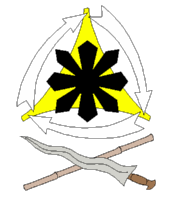

KALI HISTORY:
Kali is a martial art of the Philippines with a long and varied history. It
originally was developed by the peoples native to those islands over the centuries before
the arrival of Ferdinand Magellan and the Spanish in 1521. At that time, it was in part
based on a wavy-edged sword about 30 inches long made of wood called (in at least one
dialect) a "kalis" a modern derivative of which is the "kris". Upon
their arrival, Magellan's force was engaged in a ferocious battle (or so the legend goes)
by the islanders wielding such weapons. Their leader Lapu Lapu killed Magellan and
the Spanish were repelled even though the heavily armored Spanish had superior metal
weaponry. Today Lapu Lapu is considered by many to be a national hero of the Philippines (Dr.
Jose M. Rizal is the official national hero).
Eventually the Spanish did take over the island, kali was banned, and the traditional
weapons confiscated. The art was subsequently taken underground. The use of kalis shifted
to sticks or "baston" commonly made of rattan. Through the years the name of the
art changed to the Spanish derivative "arnis de mano". But the martial art and
spirit lived on. Today kali, arnis and, as it is also known, eskrima continues to be
taught in the Philippines and around the world. Masters like the Canetes, Leo Gaje jr.,
and proponents like Dan Inosanto (friend, student and teacher to Bruce Lee) have
ensured that kali/arnis/escrima will remain an active and vital martial art.


